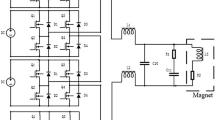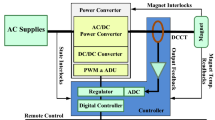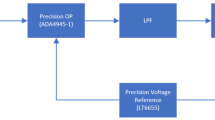Abstract
Background
Fourth-generation photon sources like Free Electron Lasers (FEL) and Diffraction-Limited Storage Rings (DLSR) have high requirements for beam emittance. In the case of DLSR sources, a set of high-performance fast orbit feedback system (FOFB) is needed to correct the beam orbit quickly and accurately.
Purpose
FOFB system has four key components, which is BPM, orbit feedback calculation, fast correction magnet and fast corrector power supply. The FOFB gives the correction command and controls the fast corrector power supply to drive the fast correction magnet to correct the beam quickly and accurately. The corrector power supply has an important impact on the performance of FOFB. The corrector power supply needs to have high bandwidth and low output current ripple.
Methods
The new GaN power device is used to solve the restriction of the high-speed switching. The switching frequency of the power supply is increased to 300 kHz. The control system is designed to improve the bandwidth and optimize the output current ripple. The modeling analysis of the key parts of the system is given and the simulation experiments are carried out with MATLAB.
Results and conclusion
The test results showed that bandwidth of the designed power supply is 20 kHz. The step response time is 18us and output current ripple is lower than 1 mA.
Similar content being viewed by others
Avoid common mistakes on your manuscript.
Introduction
At present, the fourth generation of photon sources are mainly FEL and DLSR [1]. It has high requirements for beam emittance [2,3,4,5]. The vibration of foundation and the output noise of power supply system have a great influence on the beam stability of photon source [6, 7]. Therefore, it is necessary to apply a set of high-performance FOFB to correct beam orbit quickly and accurately. The bandwidth of corrector power supply has a significant impact on the bandwidth of the FOFB.
A high bandwidth power supply is designed. In this paper, the topology of power supply is given. The advantages of GaN devices in high-speed switching are given and the simulation model of power supply is established and analysed. The simulation prototype is built for test. The bode diagram and according test curves are given.
Design parameters and system design
The design parameters of the power supply are shown in Table 1.
The power supply is designed with a single-phase full-bridge topology and a second-order LC low-pass filter. The topology design of power supply is shown in Fig. 1.
Key parts analysis
In power design, there are two aspects that have important effect on the performance of the power supply. They are the characteristics of load and the characteristics of output low-pass filter.
For these parts, the transfer function is shown in formulas (1)-(2).
The transfer function of load:
The transfer function of second-order low-pass filter:
In the control design, the characteristics of controller have important effect on the performance of the power supply. In order to minimize the lag effect of the leading pole introduced by the load, a PI regulator with compensation is designed as the system controller. In the controller system design, the PI controller is used to improve the low-frequency performance of the control system. The compensation link is used to improve the high-frequency performance of the control system. The structure of controller is shown in Fig. 2. The transfer function of controller is shown in formulas (3).
The transfer function of controller:
Power device selection
The designed power supply adopts single-phase full-bridge hard switching topology. The voltage of DC source is 90 V. Therefore, considering the voltage spike caused by the switching process of the power device, the withstand voltage selection of the power device is determined as VDS ≥ 300 V, and the output current is 30–45A.
By investigating the current mature power devices, the available types of the power device can be divided into the following three types: silicon Metal–Oxide–Semiconductor Field-Effect Transistor (MOSFET), silicon Insulated Gate Bipolar Transistor (IGBT), Silicon Carbide Metal–Oxide–Semiconductor Field-Effect Transistor (SiC MOSFET) and Gallium Nitride Transistor (GaN HEMT). The silicon MOSFET has the advantages of low driving power, strong current turning off ability and fast switching speed. The silicon IGBT has the advantages of low on-resistance and large output current [8]. However, it has low working frequency than silicon MOSFET. SiC MOSFET has the characteristics of high withstand voltage and low impedance. SiC MOSFET has good reverse recovery characteristics, and the device can work at high frequency (> 20 kHz) [9,10,11,12]. GaN HEMT belongs to the third-generation wide band gap semiconductor device. GaN HEMT has the advantages of fast switching speed, low power loss and low cost [13,14,15]. The power devices on sale are selected for comparison. The specific data are shown in Table 2.
By data comparison, GaN HEMT has the smallest Qg and therefore has faster switching speed.
The switching performance of silicon MOSFET (IPP410N30) and GAN HEMT (IGT40R070D1) is simulated by using the simulation software PSpice. The parameters of power device simulation are shown in Table 3.
The simulation draw is shown in Fig. 3.
The results of switching performance simulation for different power devices are shown in Fig. 4.
Through data analysis, GaN HEMT (IGT40R070D1) has better switching performance than silicon power device (IPP410N30N). Therefore, GaN is used as power device in this design. The power devices of Infineon are selected as switching devices (IGT40R070D1). The system switching frequency is set to 300 kHz.
Simulation experiment
An entire power supply simulation model is built by MATLAB. The simulation analysis consists of two parts. They are linear analysis and performance test.
Linear analysis
The linear analysis mainly completes the frequency domain response analysis and gives the bandwidth of the system. The simulation model is shown in Fig. 5. The Bode curve is shown in Fig. 6.
The simulation results show that the system has—1 dB amplitude attenuation at 20 kHz. The designed system bandwidth meets the design requirements.
The parameter simulation of the key second-order LC low pass filter (LPF) in the system is carried out, and its influence on the system performance is given. The simulation parameters of the 2nd order LC LPF are shown in Table 4. The test curve of 2nd LC LPF is shown in Fig. 7.
The second-order LC lLPF mainly affects the response. In the Bode diagram, it affects the turning frequency of the system, causes the resonance peak of the control system, and reduces the stability of the system at the resonance peak frequency.
Performance test
A simulation prototype is built for performance test. The simulation prototype and power part are shown in Fig. 8. The parameters of simulation prototype are shown in Table 5. The control part parameters of simulation prototype are shown in Table 6.
Step response test
Output current of simulation prototype is set to 0.15A step waveform. The test curve of step response test is shown in Fig. 9.
After data analysis, the step response time of the simulation prototype is 18.6us.
Bandwidth test
Output current of simulation prototype is set to 0.15A sine waveform. The test curves of bandwidth test are shown in Fig. 10. The test data of bandwidth is shown in Table 7.
The test results show the bandwidth of simulation prototype reach 20 kHz.
Output current ripple
The test curve of output current ripple is shown in Fig. 11.
The test results show that the output current ripple is lower than 1 mA.
Conclusion
Through the simulation analysis of power devices, we know that GaN HEMT has better switching performance and less switching loss than silicon power device, which is more conducive to the design of power circuit. Through the full simulation experiment of the designed system, the feasibility of the design scheme is verified, which lays a solid foundation for the next power design and analysis.
References
S. Lei, S. Fenglei et al., Overview of special power supplies for advanced synchrotron radiation source. High Power Laser Particle Beams 31(4), 12–17 (2019)
J. Xiaoming, W. Jiuqing, Q. Qing et al., Chinese high energy photon source and the test facility. Sci Sin Phys. Mech. Astron. 44(10), 1075–1094 (2014). ((in Chinese))
X.I.A.N. Dingchang, Present Status and Development of Synchrotron Radiation. Bull. Natl. Nat. Sci. Found. China 6, 321–325 (2005)
P. Liu, Research on fast corrector magnet power supply for HEPS (University of Chinese Academy of Sciences, Beijing, China, 2020)
Xu. Peng Liu, F.L. Wang, Fast corrector power supply design for HEPS [J]. Radiat. Detect. Technol. Methods 4(1), 56–62 (2019)
B.-S. Wang, K.-B. Liu et al., Digital Controller Implementation of a Corrector Power Converter for TPS Fast Corrector Magnet. Inform. Electron. Eng. 7(4), 127–131 (2017)
R. Garcia-Gil, J.M. Espi, F. Voelker, E.J. Dede, J. Castello, “A novel four-quadrant power supply for low-energy correction magnets.” Nucl Instrum. Meth. A. 510, 357–361 (2003)
JiaLin Xie, Design and research of driving circuit for silicon carbide MOSFET and silicon IGBT (University of Electronic Science and Technology of China, Chengdu, China, 2020)
IMAIZUMI M,HASEGAWA S,SUMITANI H,et al.Remarkable advances in SiC power device technology for ultra high power systems. In: Proceedings of IEEE international electron devices meeting. Washington, DC , USA, 651–654, (2013)
OSTLING M,GHANDI R, ZETTERLING C M. SiC power devices—present status,applications and future perspective. In: Proceedings of the 23rd international symposium on power semiconductor devices and ICs. San Diego, CA, USA. 11–15, (2011)
FU L X,ZHANG X,SCOTT M,et al. The evaluation and application of wide bandgap power devices. In: Proceedings of the conference and expo transportation electrification Asia-Pacific. Beijing, China. 1–5, (2014)
AGARWAL A K. An overview of SiC power devices. In: Proceedings of the intonational conference on power,control and embedded systems. Allahabad,India. 5698670–1–5698670–4, (2010)
Yu. Wang, Hu. Ma Wei, Weibo, et al., Realization of high frequency driver circuit and high efficiency GaN HEMT power supply module. Appl. Electron. Tech. 47(7), 38–43 (2021)
Shealy J, Smart J, Poulton M, et al. Gallium nitride (GaN) HEMT’s: progress and potential for commercial applications. Gallium arsenide integrated circuit (GaAs IC) symposium. 243–246, (2002)
Xiao Lu, Reseach on wide band gap semiconductor high efficiency power amplifier. Chengdu, China: University of electronic science and technology of China, (2014)
Author information
Authors and Affiliations
Corresponding author
Rights and permissions
About this article
Cite this article
Liu, P., Long, F.L. & Li, Y. Research on high bandwidth power supply. Radiat Detect Technol Methods 6, 409–417 (2022). https://doi.org/10.1007/s41605-022-00337-1
Received:
Revised:
Accepted:
Published:
Issue Date:
DOI: https://doi.org/10.1007/s41605-022-00337-1















